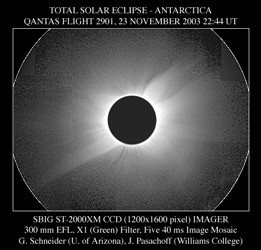 OUTER CORONA |
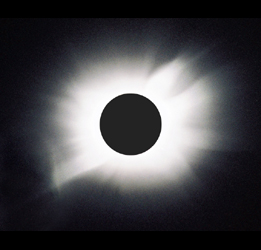 400mm EFL MID CORONA |
Video Imaging 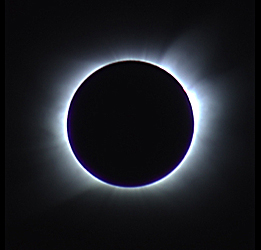 INNER CORONA (Time Resolved) |
Glenn Schneider, Steward Observatory, University of
Arizona
Collaborators: J. Pasachoff, J. Moskowitz, J.
Friedland, J-L Dighaye, M. Gill, S. Kolodny, S. Souza
IMAGES ON, AND LINKED FROM, THIS PAGE MAY NOT BE REPRODUCED
WITHOUT PRIOR CONSENT.
CONTACT: GLENN SCHNEIDER (gschneider@as.arizona.edu,
gschneider@mac.com)
EFLIGHT 2003
The glorious corona of the 23 November 2003 total solar eclipse imaged from the flight deck of a chartered QANTAS Airlines Boeing 747-400 ER aircraft (QF 2901) while over Antarctica at latitude 70°S and 35,000 feet AMSL. Four instruments viewing from the flight deck window immediately behind the head of Captain John Dennis (pilot in command), mounted on a gyro stabilized platform, recorded the advent of totality from the solar photosphere outward to an angular distance of about 6 solar radii.
Digital image processing and composition by G. Schneider
 OUTER CORONA |
 400mm EFL MID CORONA |
Video Imaging  INNER CORONA (Time Resolved) |
As preseneted at the 2nd International Solar Eclipse conference: CLICK HERE
For background information on the QF 2901: CLICK
HERE
As many know, working with Captain John Dennis, pilot in command of
QF Flight 2901 (the Cryodon/QANTAS eclipse flight) I had the unique
privilege of defining the requirements, developing the lunar shadow
airborne intercept scenario, and defining in detail the executable
flight plan that lead to our immersion in the umbra for 2m 30s centered
on 22:44 UT. Preliminary information about the flight, in general
form, was made available pre-flight here. Now that the flight is
history, the previously embargoed Mission
& Planning Definition Overview which was presented to
QANTAS airlines, is now publicly available and those who were on the
flight may find
the report itself and attached appendices A and B of interest.
Additional
post-flight information will be posted on this web site in the weeks
and
months ahead.
| An additional benefit of occupying the "second
observer's" seat, immediately behind Captain Dennis on the
Boeing 747-400 ER flight deck, was the unfettered use of the high
quality 16
inch x 28 inch window and open floor space between those two
seats to observe, photograph, and digitally image the eclipse. To make
the best use of this opportunity, a collaborative imaging program was
devised, and a four camera "common mount" three-axis
gyro stabilized platform was constructed and used during the
flight. G. Schneider with the gyro stabilized camera platform, suspended from the inward-sloping wall of the flight deck wall interior to the second observer's window, reviewing the operations procedure check sheet prior to entering the "totality run". Captain. J. Dennis in the pilot's seat. Photograph by QF 2901 First Officier Peter Ward. |
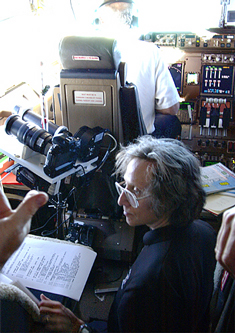 |
Camera Complement and Imaging Program:
1) SBIG ST-2000XM CCD Camera, graciously on loan from the Santa Barbara Instrument Corporation. The ST-2000 XM CCD imaging system employed a high quantum efficiency Kodak KAI-2001M 1200x1900 pixel CCD sensor. The camera head was coupled to a 300-mm singlet lens and X1 (green) filter assembly, built for previous eclipse studies, and provided a passband overlapping that used by the SOHO/LASCO C2 coronagraph. The scientific program was arranged by J. Pasachoff. Technical aspects of the apparatus and the imaging program were devised by S. Souza (Williams College) and were executed by G. Schneider under autonomous computer control during the flight. This program acquired green-filtered coronal images, executing a repetitive sequence of 10, 20, and 40 millisecond exposures with an inter-exposure cadence of 4 seconds throughout the total phase of the eclipse.
2) NIKON F5 35mm film camera, 400mm f/5.6 Vibration Reduction Lens, Fuji NPZ 800 film (push processed 2 stops to ISO 3200). This camera would provide color imagery of the mid to outer corona to about 5 solar radii. A uniformly spaced series of exposures, with a cadence of 5.36 seconds, was executed between contacts 2 and 3. A log-normal series of exposure durations 40 milliseconds after contact 2, ramping up to 160 milliseconds at mid eclipse, then ramping back down to 40 milliseconds prior to contact 3 were taken.
3) PENTAX 35mm film camera, 500mm f/8 Tamaron Lens with 1.4x focal extender, Kodachrome K-64P film. This camera would provide color imagery of the inner to mid corona from just above the occulted photosphere to about 1.5 solar radii. The exposure sequence with this camera was executed synchronously with Camera 2, but the log-normal exposure durations began and ended with exposure times of 10 milliseconds.
Both 35mm film camera were autonomously controlled with Umbraphileon a Macintosh Powerbook.
4) SONY DCR TRV 900 NTSC, three CCD Digital Video Camera. This camera, primarily, was intended as a platform guide camera streaming real-time video to the Macintosh screen display, but also was set to record the video imagery during the eclipse.
The optical axes of the four cameras were co-aligned and mounted on a common platform. The common camera platform was inertially stabilized by two orthoganally mounted Kenyon KS-8 dual-gyro stabilizers*. The platform, balanced to point upward at 14.9 degrees (the altitude of the Sun at totality) was critically adjusted to null out any torques, and suspended by a bungie cord to allow free reaction against any change in aircraft attitude, orientation and also body jitter. The bungie cord was secured to the wall of the flight deck above the window by means of a 70 lb. static load 6-inch diameter vacuum suction cup. The whole rig hung immediately behind the pilot's seat. Batteries, inverters, power supplies, computers, cabling, and other support equipment were velcroed to the back of the pilot's seat, to the flight deck floor, and anywhere else where room could be found.
AND... How Did We Get All This Stuff On The Airplane??? See HERE.
* My personal thanks to Ron Dexter cinematographer, videographer, camera man, director, for the benefit of his helpful and frequent advice on the construction and use of the gyro platform as it evolved.
Two of the four cameras for which the results on this page are
discussed are shown in the image below (the other two are on other side
of the platform). Anybody venture a good caption for this photo?
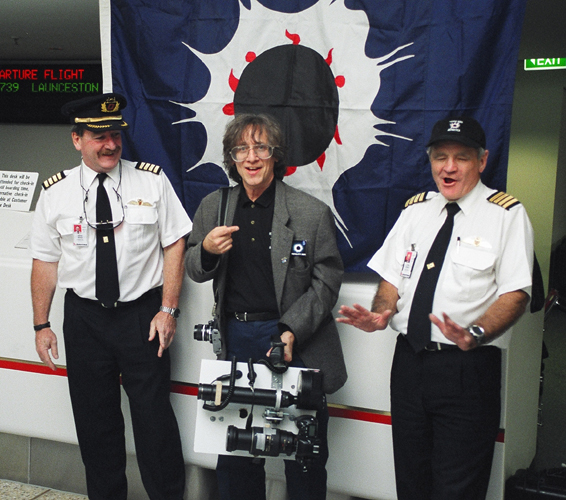
Left to Right: Cpt. Brian Meade, Glenn Schneider, Cpt. John Dennis
(PIC)
Photograph by Jay Friedland
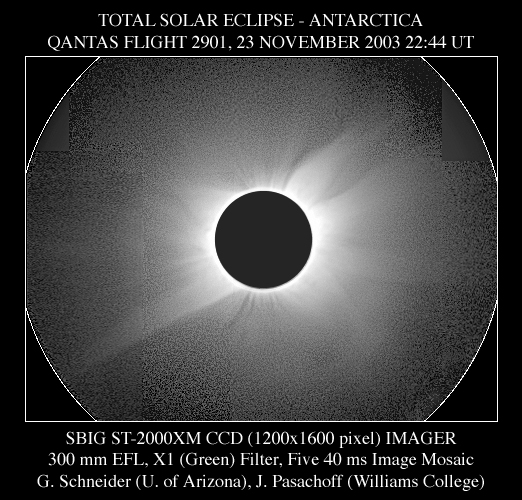
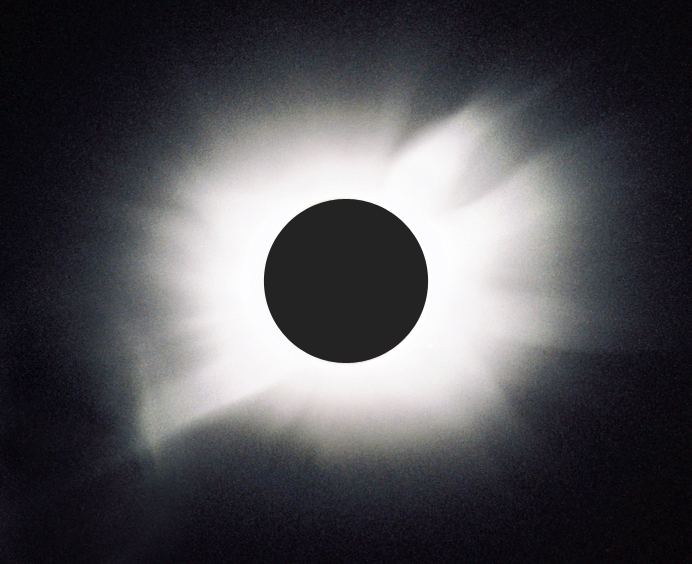
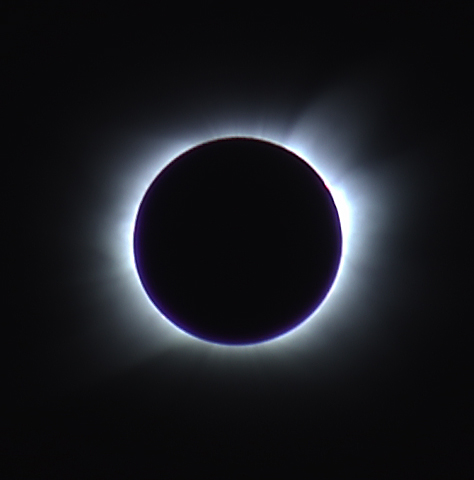
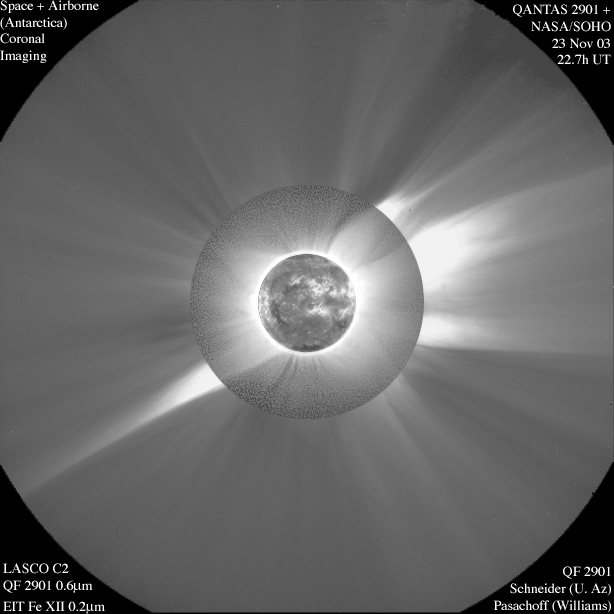
More will be coming!!!!
http://nicmosis.as.arizona.edu:8000
OTHER QF 2901 REPORTS:
University of Arizona (Pre-Flight)
J-L Dighaye
Howard
Anton Duncan
John
&
Leticia Ferrer
Jay
Friedland
Spencer
Howson (ABC Brisbane)
Steve
Kolodny
Dan Lynch
Paul
Maley
Jay Pasachoff
Brigget
Benz & Alan Dyre
Steve
McLachlan (Philately)